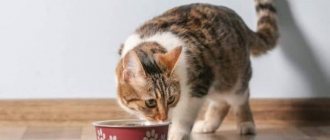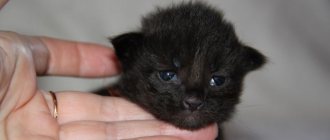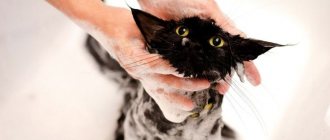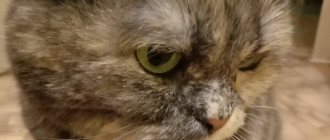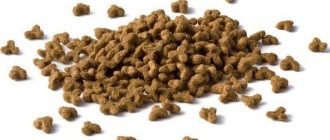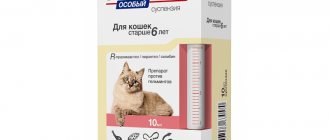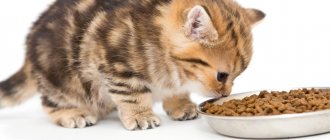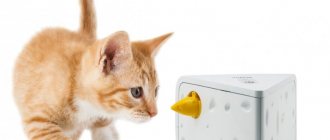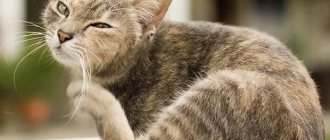Brewer's yeast for cats, cats and kittens is a possible dietary supplement. However, they should be included in the menu not randomly, but according to the rules. Many cats adore treats so much that they are ready to dance in front of their owner if only he would give them a treat. But not everyone needs or is allowed this product. Let's figure out whether a cat can eat yeast, what it should be, how, when and why to use it.
This article is part of the category Nutritional Supplements for Cats
Can cats eat brewer's yeast?
Brewer's yeast is the dried single-celled yeast fungus Saccharomyces cerevisiae. These same fungi are used in brewing.
Article continues after advertisement
For the first time in the world, brewer's yeast in its pure form was obtained by the Danish botanical chemist Emil Hansen. At the end of the 19th century, pure cultures were isolated and used in brewing at the oldest brewery, Carlsberg. Before this, “wild” ones were used.
Knowing that we are talking about fungi, some people are afraid to give them to animals. In fact, fungi are different: some cause pathological conditions, others are useful. Beer houses belong to the second category. Moreover, they contain many amino acids and are considered an easily digestible protein. Therefore, brewer's yeast is allowed for cats. Moreover, it is worth considering that this product as a supplement is sold in a dried, deactivated state, so even with the best intentions, fungi, once in the body, will not be able to multiply.
Brewer's yeast for kittens is allowed from the age of 2 weeks. It doesn't matter whether you buy them for British, Scottish kittens or another breed. Although there is no need for early introduction of the supplement into the diet if the animal receives adequate nutrition for its age.
Indications for the purpose and use of nutritional yeast
Accordingly, the drug shows maximum effectiveness in the following cases:
- Vitamin deficiencies.
- It is very useful to give to old cats and cats, as the supplement can delay the process of final aging of the body and improve the quality of life of an elderly pet.
- The recovery period after serious illnesses, injuries, and in the postoperative period.
- Tremors are very useful for pregnant and lactating cats.
- The drug is prescribed to cats and female cats actively used for reproductive purposes.
- Brewer's yeast is actively used by animal owners who often participate in exhibitions. As we wrote above, the drug relieves the effects of stress, and also contributes to a noticeable improvement in the condition of the skin and coat.
- In addition, nutritional yeast is very useful for animals recovering from severe helminthic infestations.
The benefits of brewer's yeast for animals
The benefits of a drug such as yeast for cats directly depend on its composition. And he is the following:
- 14 vitamins (in particular, the entire group B);
- minerals (phosphorus, potassium, copper, zinc, sodium, magnesium, selenium, sulfur);
- oligosaccharides;
- amino acids;
- fatty acid.
The basis of the drug is proteins, and they are easily digestible - this is one of the reasons why brewer's yeast is useful for cats. The second reason is its rich composition of vitamins, minerals and fatty acids. These substances significantly improve the quality of wool and skin. In addition, the oligosaccharides included in the composition bind harmful bacteria in the intestines and remove them from the body, normalizing the microflora.
The additive is used for the following purposes:
- elimination of hypovitaminosis;
- normalization of metabolism;
- combating loss of appetite and weight;
- combating the effects of stress;
- increasing immunity;
- acceleration of cell regeneration;
- prevention of dermatitis;
- improvement of hematopoiesis;
- reduction of molting time;
- improvement of coat;
- strengthening of fur pigmentation.
Some experts advise giving pets yeast instead of synthetic vitamins, which are taken in courses 2-3 times a year when the animal does not eat fortified food. It is believed that since this drug is natural, the beneficial substances from it are absorbed better: the body perceives them as food, and not as a foreign additive.
At the same time, there have been no clinical trials that would prove the usefulness of yeast for cats. There is only theory and subjective opinions: many owners note an improvement in the coat and condition of the pet after a course of the drug. However, such reviews cannot be considered objective, because there was no laboratory confirmation. In addition, along with the presence of satisfied owners, there are those who have not noticed any changes.
As for the author of this article, he was initially skeptical about such a supplement for cats on a nutritious diet. But after conducting the experiment, he assessed the effect of the supplement: despite the fact that the cat receives raw natural food, that is, all the necessary substances enter the body, after 2 weeks of taking ordinary brewer's yeast from the pharmacy, the quality of the coat sharply improved - it became silkier and almost completely The shedding has stopped.
Article continues after advertisement
But the idea that brewer's yeast repels fleas if a cat eats them regularly is a myth that scientists have debunked. The study found that eating brewer's yeast does not repel insects.
Dependence on dry food.
If your cat refuses any food other than dry food, don't stop trying to change the diet.
Any cat can be transitioned to a water-rich, low-carbohydrate diet with enough patience and a little creativity. The consumption of dry food is associated with three main problems:
- Water content too low.
Increases the likelihood of cats developing serious and life-threatening urinary tract diseases. Among them are extremely painful and often fatal (and requiring expensive treatment) such as urethral obstruction. - Too high carbohydrate content.
Causes a predisposition to diabetes, obesity and intestinal diseases. Note that low-carb dry foods are also not considered healthy foods because they contain little moisture and lose nutrients when cooked during manufacturing. - The content of plant proteins is too high
relative to animal proteins. Cats are obligate carnivores, their bodies are adapted to eating meat. Herbal components are needed only to increase the profits of manufacturers and do not contribute to the preservation of cat health.
Among other problems:
- bacterial infection (can cause vomiting and diarrhea);
- fungal mycotoxicoses (due to fungi contained in cereal grains that produce extremely toxic substances);
- insects and their feces (can cause breathing problems);
- ingredients that often cause allergic reactions;
- lack of nutrients due to their loss during the production of feed;
Dosage
Brewer's yeast is mixed into cats' food or offered separately in tablet form. As a rule, cats love their smell and swallow the pill themselves.
Here is an example of using yeast as a food additive according to the BARF system (Bones And Raw Food Diet - a diet based on raw meat and bones). Ingredients: 65% - chicken backs with meat, 10% - chicken heart, 10% - salmon, 5% - chicken liver, 5% - bran (this is a source of fiber, although in cat nutrition it is considered a controversial ingredient), 5% - kelp , a pinch of brewer's yeast.
As a preventative measure, cats are given brewer's yeast in the following dosage: 1 tablet (usually the weight of one tablet is 0.5 g) during or after meals, 1 time per day in the morning. The dosage is calculated based on 0.5 g of the drug per 5 kg of animal weight. That is, an animal weighing 3-7 kg can receive 1 tablet per day, an animal weighing 8-12 kg can receive 2 tablets per day. The dosage of brewer's yeast for kittens is less: half a tablet once a day.
The information above concerned prophylactic doses. But yeast is also served as part of complex treatment for the following indications:
- deficiency of B vitamins;
- disorders of mineral and carbohydrate metabolism;
- pathologies of the digestive system;
- skin diseases;
- poor nutrition;
- diseases of the nervous system;
- intoxication;
- adaptation to negative environmental factors;
- and others.
When using the drug in the complex treatment of a particular pathology, it is necessary to follow the dosages prescribed by the veterinarian. You should not prescribe therapeutic doses yourself.
Not only the dosage is important, but also the form. You need dry yeast, not liquid yeast with live cultures. Live ways to start the fermentation process in the digestive tract and disrupt intestinal function. Pharmacy tablets contain dry yeast - inactive fungi, which are a nutrient, but are no longer capable of being active.
The supplement can be purchased at a regular human pharmacy, but with one caveat. This should be a tablet containing only brewer's yeast, with no added synthetic human vitamins and minerals.
Many people ask what is the appropriate dose of baker's yeast for a cat? We answer. None. Don't give baker's yeast to cats: it's a different type - it's not healthy.
References
- Maksimova, A.V., Smolkin, Yu.S. Allergic reactions to vaccine components in justifying the tactics of preventive vaccination of sensitive patients: an analytical review. ConsiliumMedicum, 2022. - No. 3.
- Bansal, R., Tadros, S., Bansal, A. Beer, Cider, and Wine Allergy. Case Reports Immunol., 2022.
- Pajno, G., Passalacqua, G., Salpietro, C. et al. Looking for immunotolerance: a case of allergy to baker's yeast (Saccharomyces cerevisiae). Eur Ann Allergy Clin Immunol., 2005. - Vol. 37(7). - P. 271-2.
- Musatti, A., Mapelli, C., Rollini, M. et al. Zymomonasmobilis Substitute Saccharomyces cerevisiae in Cereal Dough Leavening? Foods, 2022. - Vol. 7(4). - P. 61.
Contraindications
There are contraindications to the use of brewer's yeast. This is an individual intolerance and the presence of an allergy to this product. If you know about such a feature of your pet’s body, but the cat eats yeast, begs for it and shows interest in every possible way, this is not a reason to indulge him. Cats often ask for things they can't. US veterinarian Karen Baker warns against using brewer's yeast for animals prone to allergies :
I do not recommend feeding cats brewer's yeast, which is an allergen for many animals. B vitamins can be obtained naturally from raw meat.
There are no other contraindications other than a tendency to allergies. In any case, no side effects have been detected in anyone yet.
Article continues after advertisement
Alternative
From a physiological point of view, a natural diet based on meat and cereals is more useful. The intestines of a predator are adapted for processing hard protein foods; soft foods cause digestive disorders and lead to tooth damage. Proper natural feeding requires a lot of time and expense.
Most owners feed their pets with ready-made food. Their advantages:
- provide balanced nutrition;
- facilitate the calculation of the required calorie intake;
- have a long shelf life.
Dry food is divided according to quality into the following groups:
- Economy class - Friskies, Kitekat. Contains 5% protein, a large amount of starch, preservatives.
- Premium class - Royal Canin, Proplan, Brit Premium. Includes animal and plant proteins 30-40%, preservatives. The composition is clearly indicated on the packaging. Average price 600 rub. for 1.5 kg.
- Super premium class - Brit Care, Bozita. Proteins of animal origin at least 40%. Average price 900 rub. for 2 kg.
- Holistics - Acana, Applaws, Grandorf. Contains up to 90% quality meat and fats. Average price 1200 rub. for 2 kg.
Large packages are usually cheaper.
If it is impossible to buy quality food, natural food will be preferable to harmful crackers with an artificial taste.
Some cats, having become dependent on Whiskas, flatly refuse to eat other food. You need to wean your animal off harmful products gradually by adding high-quality food to the diet. Start with minimal amounts that are invisible to the pet, gradually reducing the proportion of Whiskas. In 2-3 months you can painlessly wean your cat off junk food.
The harmfulness of Whiskas for cats and kittens is undeniable. The gloomy joke of veterinarians that as long as economy-class food exists, they will not face unemployment is not at all funny. Pets cannot choose their own food. It is the owner's responsibility to provide a safe and nutritious diet.
Where to buy brewer's yeast for a cat?
Brewer's yeast is sold as a supplement in veterinary clinics, pet stores and human pharmacies. A dietary supplement for humans and animals is no different if you buy it in its pure form without additional ingredients.
The price of brewer's yeast for cats varies depending on the brand and composition. Other types of preparations for cats containing yeast are also sold.
Pure brewer's yeast without additives
The most versatile and safest option is brewer's yeast without any additives. You can look for these in a human pharmacy, but there, most often, yeast is sold with additives of other ingredients and contains calcium, magnesium and other elements in human doses. Such supplements are not suitable for cats. But in the American store iHerb there is pure brewer's yeast without any additives. Brewer's yeast from NOW is ideal in terms of price-quality ratio.
BUY ON iHERB
Brewer's yeast with garlic
Garlic is used to expel parasites, but at the same time it is a questionable ingredient in cat nutrition. In its raw form, it can cause anemia, and as a preventive measure for worms, it only works when the garlic is fresh and there is a lot of it.
BUY ON AMAZON
Brewer's yeast as part of complex additives
Often, supplement manufacturers also add additional microelements to the drug. Some may be useful, while others, under certain circumstances, lead to excess in the body and cause pathologies. Therefore, consult your veterinarian before use.
Article continues after advertisement
BUY IN RUSSIA
BUY ON AMAZON
BUY IN UKRAINE
Brewer's yeast with specialized additives
The succinic acid in the composition helps weakened animals protect the body from external factors. This supplement is especially useful for older cats. If the drug contains sulfur, this means that the tablets are also aimed at strengthening cartilage, ligaments and bones. And seaweed (kelp) cleanses the intestines and is a natural source of iodine. By the way, it can be added to food separately in powder form.
Yeast with calcium is necessary for cats whose diet lacks this element. This often applies to those who are on a natural diet, but do not receive the bone component. But the calcium must be in the form of citrate, which is rare in yeast supplements.
Sometimes chitosan is added to the composition. It is a fiber extracted from the shells of crustaceans. Due to its ability to bind metal ions, including toxic ones, chitosan is used to cleanse the body of toxins.
Yeast in feed
Yeast is often present in commercial animal feed. It is worth paying attention to how the ingredient is indicated on the label. If the ingredients simply contain “yeast,” this means that we are most likely talking about baker’s yeast, which are cheaper and are not good for cats. If it contains beer, the manufacturer writes so.
If this ingredient is listed at the very beginning of the list, this is bad: the manufacturer is using yeast to try to increase the amount of protein in the feed, thus replacing the more expensive component - meat.
In addition, the label of a good food will indicate the percentage of each component. Choose these foods if for some reason you have given up natural feeding.
Or maybe instead of yeast, a complex preparation with B vitamins?
If your cat is allergic to brewer's yeast but is deficient in B vitamins in her diet, you may want to consider supplementing with a supplement other than yeast. This drug from Dr. Mercola is based on beef bone broth and quinoa seeds.
BUY ON iHERB
Article continues after advertisement
Characteristics of economy class dry food
From the above it follows that the harmfulness of dry food lies not in its form, but in the imbalance in a number of nutritional components. The raw materials for economy-class dry food are waste from meat processing plants. Coarse grains containing allergens and antinutrients are used as sources of carbohydrates. They are inactivated by extrusion, but not completely. To make the food more attractive, flavorings and taste correctors are added. The following brands are popular in Russia:
- Kitty-Kat.
- Dr. Clouder.
- Whiskas.
- Friscas.
The demand for such food is due to the low purchasing power of the population.
The harmfulness of such foods is established if they are fed to purebred cats. Sterilization makes animals more vulnerable. But such products are popular among owners of outbred felines. Cats fed dry or wet economy-class food live up to 10–15 years, so it is impossible to determine what exactly caused their death.
The most characteristic symptoms of pathologies caused by unbalanced feeds are urolithiasis and allergic manifestations.
Kitty-Kat food
Dry food causes urolithiasis
Many cat owners fear that feeding dry food can cause urolithiasis in their pets. The logic is this: cats naturally have a reduced sense of thirst, and since ready-made industrial diets contain virtually no moisture, the animals that feed on them experience an acute lack of fluid.
In fact, this is nothing more than a myth. The feeling of thirst is regulated in the hypothalamus of the brain and is directly related to the amount of fluid supplied with food. A cat eating canned food or natural food may not drink water at all, and this is the norm for it. If there is not enough liquid in the food, then a signal generated in the animal’s brain will force it to look for water in order to compensate for its lack in the body. The owner's task is simply to provide the cat with constant access to clean, fresh water.
In addition, the development of urolithiasis itself is not associated with the amount of fluid consumed, but with the composition and pH balance of urine, which directly depend on the composition of the food, and not on the amount of moisture in it. Feeds high in carbohydrates cause urine to become alkaline, leading to the most common type of disease, struvite.
Release form, composition and packaging
Pills
from light gray to dark gray in color with inclusions, biconvex, with a notch on one side, with a peculiar smell; with an average weight of 0.4 g with a diameter of 9.9-10.2 mm (for dogs and cats) and 2.1 g with a diameter of 19.8-23 mm (for large dog breeds).
| 1 tab. | |
| brewer's yeast (Saccharomyces cerevisiae) | 91% |
| garlic | 1.2% |
| oils and fats (glycerin, 0.8% tuna oil, stearic acid, safflower oil) | 6.9% |
Excipients
: silicon dioxide - 0.9%.
Does not contain genetically modified products.
1 tablet contains:
| Components | In a tablet weighing 0.4 g | In a tablet weighing 2.1 g |
| Crude protein, not less than % | 43 | 43 |
| Crude fat,% | 7 | 7 |
| Crude fiber,% | 1 | 1 |
| Moisture,% | 8 | 8 |
| Vitamin B1, mg | 0.32 | 1.68 |
| Vitamin B2, mg | 0.2 | 1.05 |
| Vitamin B6, mg | 0.024 | 0.126 |
| Niacin, mg | 0.48 | 2.52 |
| Iron, mg | 0.77 | 4.02 |
| Biotin, mcg | 0.76 | 4 |
| Copper, mg | 0.001 | 0.005 |
| Manganese, mg | 0.13 | 0.7 |
| Zinc, mg | 1.31 | 6.87 |
| Cobalt, mg | 0.045 | 0.24 |
Permissible deviations in the content of components from those specified in the recipe should be: for microelements - no more than 10%, for vitamins - no more than 15%. The content of harmful impurities does not exceed the maximum permissible standards in force in the Russian Federation.
Packaged in 80, 140, 260, 780 and 1430 pcs. in polymer jars of appropriate capacity with screw caps.
Each package is labeled in Russian indicating: the name of the manufacturing organization, its address and trademark, name, purpose and method of use of the additive, composition and guaranteed indicators, shelf life and conditions, batch number, tablet weight, number of tablets in the package, date manufacturing, information about certification, the inscription “For animals” and provide instructions for use.
